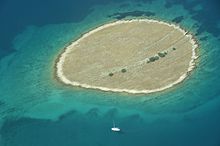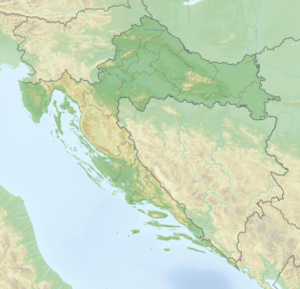Kornati islands
| Kornati islands | ||
|---|---|---|
| Waters | the Adrian Sea | |
| Geographical location | 43 ° 47 ' N , 15 ° 20' E | |
|
|
||
| Number of islands | 125 (152 according to other sources) | |
| Main island | Kornat | |
The Kornati Islands , also known as Kornati Islands , ( Croatian Kornatski otoci or Kornati , Italian Isole Incoronate ) are the largest and densest group of islands in the Croatian Adriatic . They consist of 125 to 152 (depending on the source) small islets and reefs. The karst islands are only sparsely overgrown. The largest island of the Kornati is called Kornat and gives the group of islands its name, but the administrative seat of the area is on the island of Murter . Today parts of the archipelago are protected by the Kornati National Park .
geography
The archipelago extends along the Croatian coast between the cities of Zadar in the north and Šibenik in the south. In the northwest of the group is the island of Dugi Otok . To the east there are Pašman , Vrgada and Murter . Further south lies Kornat , in the southeast Žirje . Numerous smaller islands are grouped around them. The Kornati are made of water-permeable and water-soluble limestone, which allows the precipitation to seep away so that there are no springs or watercourses, only in some places the fresh water of the precipitation emerges from the karst and mixes with the salt water of the sea. In the karstified wasteland there is almost no flora , only barren scree fields that are partly overgrown with grass. In some depressions on the landward sides, protected by steep cliffs and reefs facing seaward, soil can be deposited. Small trees and shrubs grow there and there are some settlements in sheltered bays. Cultivated olive trees, fig trees and grapevines, which are fed by rainwater collected in cisterns , also thrive there. The fishing grounds around the Kornati are among the richest in fish in the Adriatic Sea. The climate is characterized by long periods of dryness and irregular rainfall.
history

The Kornati were settled by the Illyrians in early antiquity , and probably the Delmaten and Liburnians , who were known for their nautical skills , sat on the Kornati islands (see Liburnian ship type ). You can still see the remains of settlements and barrows from this period. The Delmats said between 175 and 170 BC From the kingdom of the Illyrian king Genthios , but were lost in 156 BC. Defeated by the Romans in BC and paying tribute until they were incorporated into the Roman Empire as the province of Dalmatia at the time of Augustus . The Kornati were also inhabited in Roman times, remains of Roman settlement were found on Kornat , and there was also an early Christian church here. Until 1102 the Kornati were in the possession of the Eastern Roman Empire , during the Great Migration the Slavic Croats settled on the coast and on the islands and displaced the previous population. At this time there were also raids by Saracens several times . In the Middle Ages, the Kornati were owned by the city of Zadar, in the 16th century the Kornati fell to the Republic of Venice , but the area was still administered from Zadar. In 1797 the islands were integrated into the Austro-Hungarian Empire together with the rest of Dalmatia . After the First World War , the Kornati were in the possession of the Kingdom of Serbs, Croats and Slovenes , from which Yugoslavia emerged in 1945 . During the Second World War from 1941 to 1943, large parts of the coastal area including the cities of Split and Šibenik and the offshore islands, including the Kornati islands, were occupied by Italy . The southern part of the archipelago , namely 89 islands and rocks and the sea around them, were declared the Kornati National Park in 1980, which covers 220 km² and is administered on Murter.

Movie
- Kornati National Park in Croatia. Report, 2002, 43 min., Written and directed: Cornelia Volk, Till Ludwig and Uwe Kassai, production: MDR , first broadcast: February 10, 2003, arte
Web links
- Kornati National Park (Engl.)



